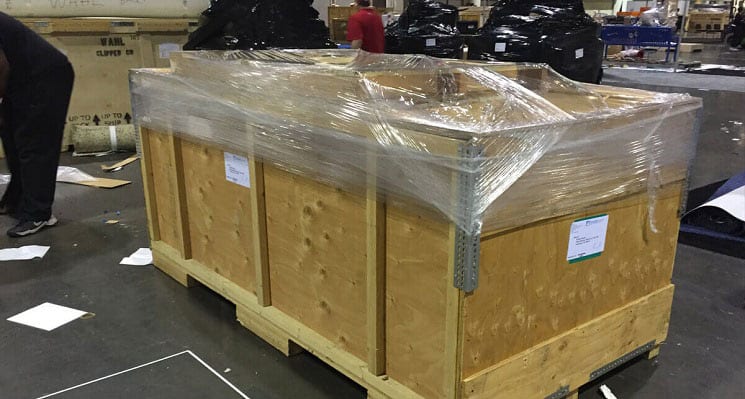Challenging the Status Quo with Affordable Alternatives
by Lesley Martin
Among exhibitors, the most misunderstood line item on their trade show invoice is material handling. Material handling, also known as “drayage,” describes moving exhibit properties to and from an exhibit space. It’s a simple concept, yet there can be 20 or more categories for the services rendered which can translate, on average, to 16 percent of an exhibitor’s budget. Yet the final cost is not disclosed until after the show closes. Exhibitors, frustrated by the lack of transparency and control, may choose other marketing tactics where the investment is transparent.
Tasks included with material handling fees
While drayage may sound as simple as moving properties from point A to B, the services provide value for the show floor. Tasks completed by the material handlers include:
- Receiving properties at advance warehouse or marshaling yard.
- Unloading properties from the truck.
- Delivering properties to the booth space.
- Returning for the empty crates or “empties” at a later time.
- Storing the empties on- or off-site.
- Returning the empties to the booth space.
- Loading the trucks once properties are packed and labeled.
Exclusive service by the general contractor
For a limited event like a trade show, a single supplier managing the logistics enables smoother set-up. In their agreements with show organizers, general contractors retain the right to offer material handling as an exclusive service. However, the monopoly of a required service holds the exhibitor hostage to the GC’s terms and rates.
As a result, rates are determined on a per show basis. There’s no consistency of rates for shows within the same city or time period, which frustrates exhibitors trying to budget. Additionally, the increase in rate categories in recent years has complicated the process. In 2003, there were four rate categories. Today, a trade show can have 24 rate categories based upon the difficulty of handling and timing of arrival.
Zero balance driving the exorbitant fees and categories
Besides the services rendered, other costs are hidden in the material handling rates. Show organizers have their own costs for show set-up, including aisle carpet, signs, and registration counters–all supplied and managed by the GC. Decades ago, show organizers negotiated with the GC to receive these services free. Since then, the rates of exclusive services have risen, and GCs offset the freebies for show organizers by upcharging exhibitors on material handling rates.
Exhibitors fleeing the show floor
The total cost of material handling is a mystery to the exhibitor until after the tradeshow closes. Without the opportunity to negotiate rates or the final invoice, the exhibitor is unfairly gouged.
Today’s exhibitor is changing, a far cry from the trade show managers of years past. Today’s exhibitor might be a millennial who has only been working a few years. Or, they might be a senior marketer who’s strapped for time and doesn’t understand tradeshows. Stung by the tradeshow experience, the inexperienced exhibitor or the exhibitor under fire from the finance department may choose other marketing tactics, like experiential or proprietary events.
In response to exhibitors’ protests, some shows have tried alternatives to the traditional material handling model. Below is a detailed explanation of the traditional model, plus the proven alternatives for the service that are simpler.
Traditional Model: Material Handling Based on Weight
Charges are based on the weight from the exhibitor’s inbound weight ticket included with their shipment. All parcels are usually charged the minimum 200 lb., or at least two-century weight (“CWT,” or cost per 100 lbs.) The CWT is multiplied by a rate determined by the GC and show organizer.
The model of charging exhibitors based on the weight multiplied by rates is inconsistent, hard to predict, and nearly impossible to budget. Additionally, the cost is not usually disclosed to the exhibitor until after the show ends.
Material handling incorporated into booth space fee
When exhibitors sign a contract reserving the booth space, the material handling rates are not published. By signing a contract blindly, exhibitors don’t have a chance to negotiate the rates, which are determined by a contractual agreement between the show organizer and the GC.
If the material handling cost is built into the space fee, the costs are transparent to the exhibitor. Additionally, the fee is proportional to the booth space and projected size of the exhibit properties. This makes invoicing and budgeting easy to track.
Show organizers provide material handling as an in-house service
Material handling is typically an exclusive service offered by the GC. However, some show organizers provide material handling as an in-house service and simplify the cost. For example, the PACK EXPO is a show for packaging equipment. Under the traditional drayage model, no exhibitors would be able to afford to bring their heavy equipment. Not wanting to lose exhibitors, and the attendees who go to see the large equipment, the show organizers provide material handling in-house. Being charged a flat rate, exhibitors can budget bringing their large equipment to show-site.
Eliminate overtime and special handling fees, and incorporate a blended rate
The GC might add a number of overtime and special handling fees. Material handling categories might be based on the location of shipment arrivals, how the materials are packed, and what deadlines are made or missed. Penalties include missed deadlines, incurring overtime charges, and shipping loose materials not stored in crates.
The categories are confusing, and the penalties aren’t disclosed to the exhibitor until after the show. When the fees are a blended rate, the overtime and special handling fees are eliminated. This simplifies the exhibitor’s budgeting, as well as invoicing for the GC.
Charge per trip, or based on time and materials
The rates charged to exhibitors are not proportional to the time and effort required. If the drayage rate is $116.70/CWT, then a neatly packed 1,100 lb. crate would cost $1,283.70. If the labor rate is $35/hour, then the cost accounts for 37 working hours, or one person working four and a half days at straight time.
If the costs are charged on a per trip basis, or time and materials incurred, then the exhibitor is only charged for the effort of directly handling their booth properties. The costs are easier to rationalize for the exhibitor.
Exhibitors take action
As the revenue generator of the trade show, exhibitors have the power and obligation to take responsibility and push for change. Before and after the show, exhibitors should band together and voice their needs to the show organizer and GC.
This story originally appeared in the January/February 2018 issue of Exhibit City News magazine, p.40-41. For more pictures and original layout, visit https://issuu.com/exhibitcitynews/docs/jan-feb_ecn2018.






























